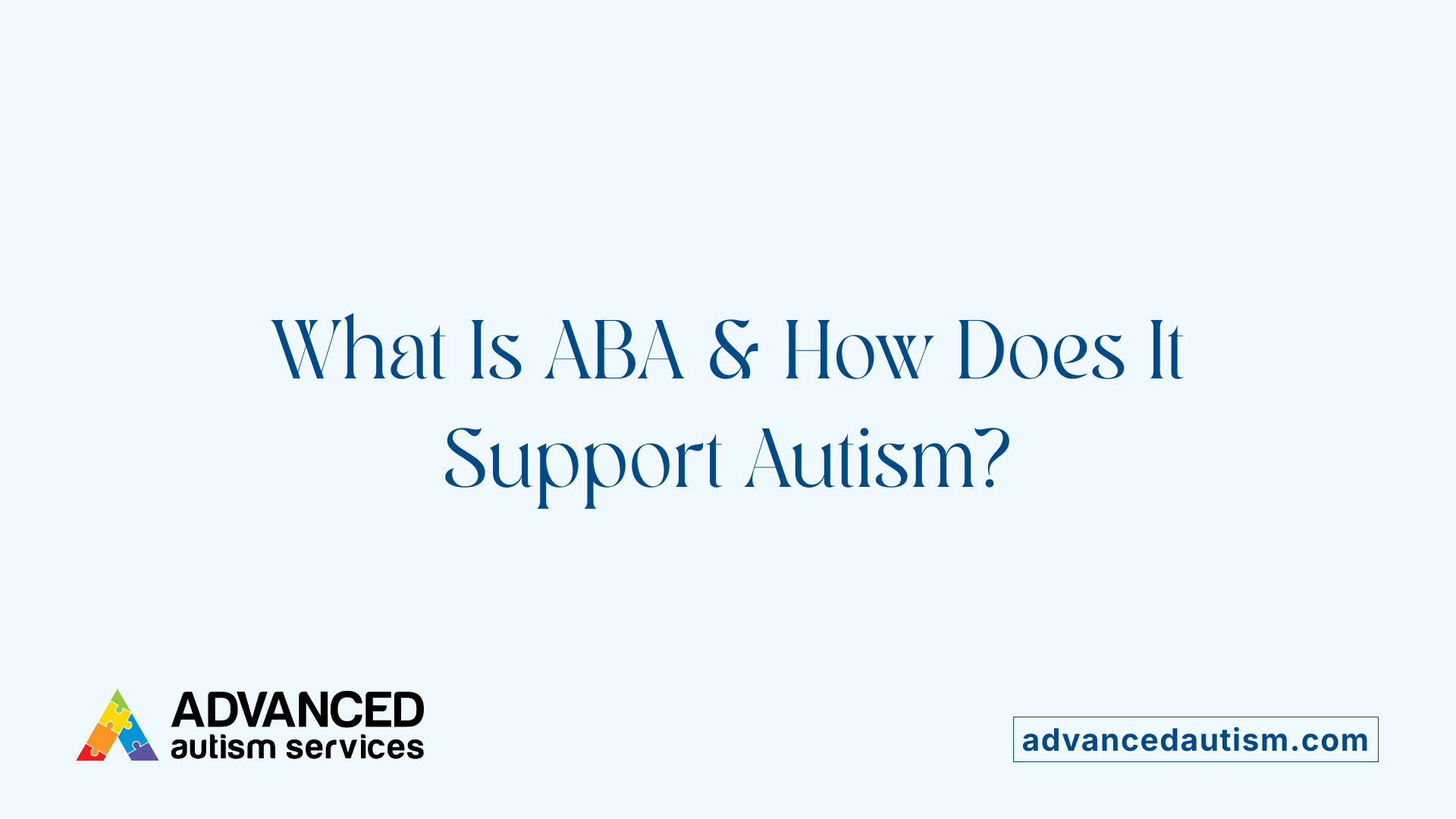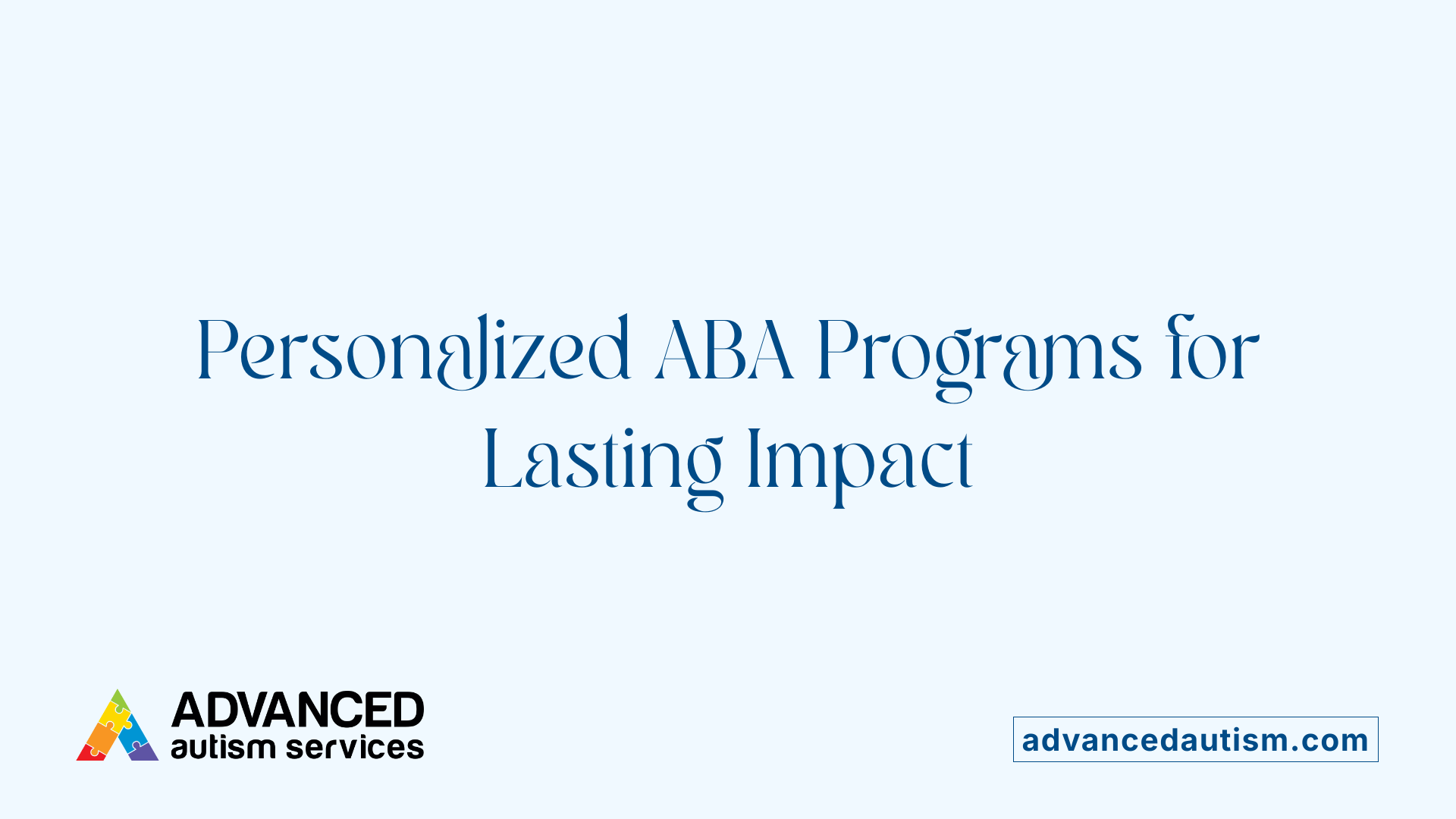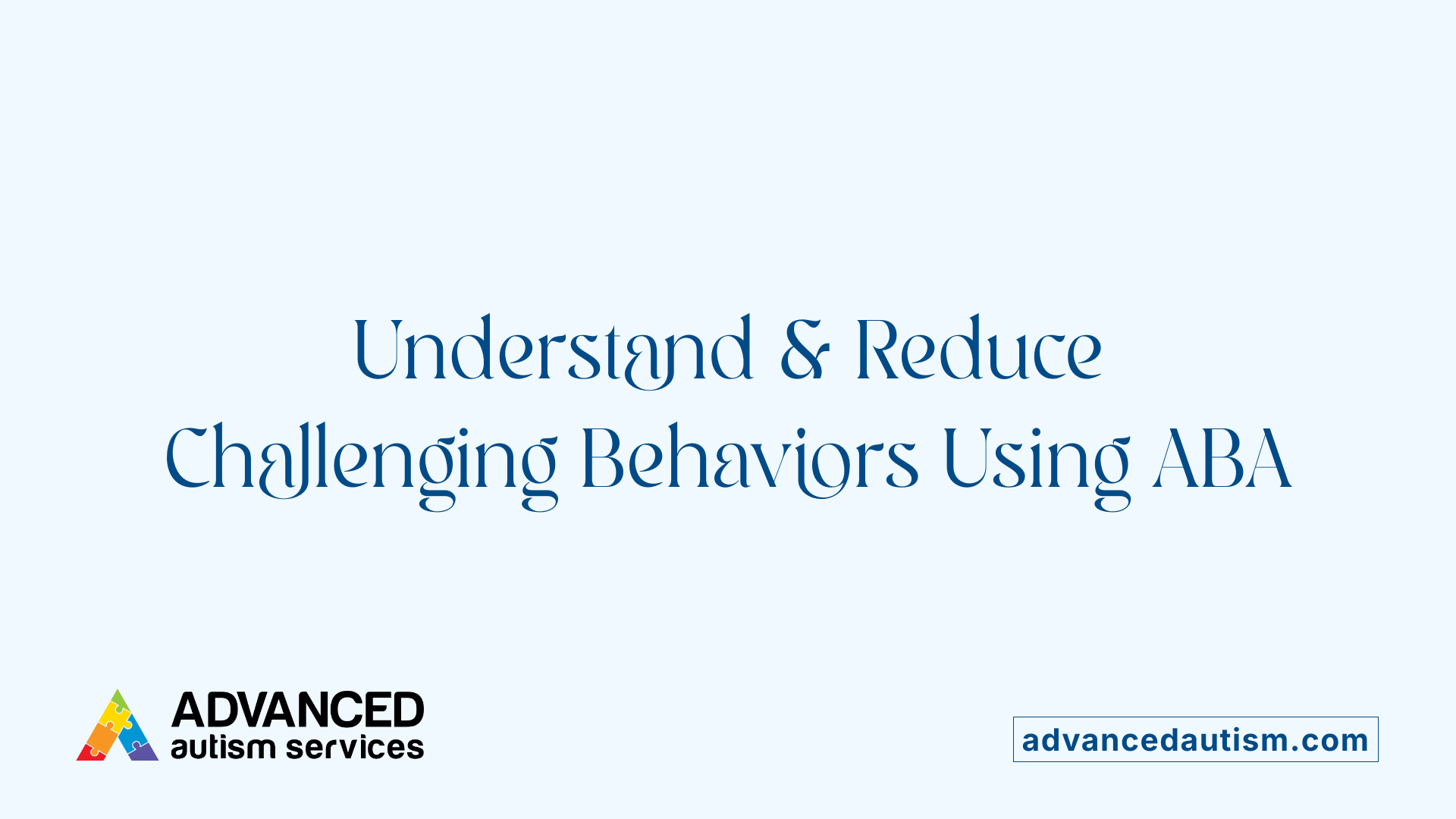How ABA Therapy Helps Reduce Challenging Behaviors
Transforming Lives Through Behavioral Science: The Role of ABA Therapy in Autism
Understanding ABA Therapy and Its Impact on Challenging Behaviors
Applied Behavior Analysis (ABA) therapy stands as a scientifically grounded approach designed to improve life skills and reduce challenging behaviors in individuals with autism. Rooted in the principles of learning and behavior science, ABA is tailored to each individual, addressing unique needs through expert assessment and targeted interventions. This article explores how ABA therapy helps minimize disruptive behaviors while enhancing communication, social interaction, and independence, offering hope and measurable progress for families and practitioners alike.
Defining ABA Therapy and Its Role in Autism Support

What is Applied Behavior Analysis (ABA) therapy and how is it used to support individuals with autism?
Applied Behavior Analysis (ABA) therapy is a scientifically supported approach that applies the principles of learning and behavior to improve various skills in individuals with autism. It focuses on increasing helpful behaviors and decreasing harmful ones by understanding the relationship between antecedents (what happens before a behavior), behaviors themselves, and consequences that follow — often summarized as the A-B-Cs.
How does ABA apply learning principles?
At its core, ABA uses positive reinforcement, which means rewarding desired behaviors to encourage their repetition. This consistent encouragement leads to meaningful and lasting behavior changes. ABA programs use both structured methods and more naturalistic techniques, all backed by data and ongoing assessments to ensure progress.
What are individualized treatment plans in ABA therapy?
No two individuals are alike, and ABA recognizes this by tailoring treatment plans to each person's unique needs and goals. These targeted goals may include improving communication, social skills, self-care abilities, play, motor skills, and academics. Such personalization ensures that therapy is relevant and effective.
Who are Board Certified Behavior Analysts and what is their role?
Certified experts called Board Certified Behavior Analysts (BCBAs) lead ABA therapy. They conduct thorough assessments, design and adjust individualized programs, and oversee progress using data collected during sessions. Their expertise ensures that interventions are scientifically grounded and adapted as needed.
What techniques does ABA use to promote positive behaviors and reduce harmful ones?
ABA employs several strategies, including:
- Identifying triggers and consequences for behaviors through the A-B-C framework.
- Training caregivers to support consistent behavior change.
- Using positive reinforcement to reward and increase desirable behaviors.
These techniques combine to foster skill-building and reduce challenges, promoting greater independence and quality of life for individuals with autism.
Who Provides ABA Therapy and Their Professional Qualifications

Who Typically Provides ABA Therapy, and What Qualifications Do They Have?
ABA therapy is mainly delivered by specialized professionals who have undergone extensive training in behavioral interventions. The most common providers include Board Certified Behavior Analysts (BCBAs), Registered Behavior Technicians (RBTs), and other trained therapists experienced in autism and applied behavior analysis.
What Education and Certifications Are Necessary?
To become a BCBA, an individual typically needs at least a master's degree in Applied Behavior Analysis or a related field. Certification is obtained through the Behavior Analyst Certification Board (BACB) by completing a Verified Course Sequence, passing a comprehensive exam, and fulfilling supervised clinical experience requirements.
RBTs, on the other hand, hold a certification that involves specific training and competency verification but work under BCBA supervision. Many providers also secure state licensure, which may involve fulfilling additional regional educational and professional criteria.
How Is Supervision and Clinical Experience Handled?
Supervision plays a vital role in ABA therapy delivery. BCBAs not only provide direct therapy but also oversee RBTs and other team members, ensuring that treatment plans are effectively implemented. They assess progress through data collection and make necessary adjustments to individualized programs.
What Role Do Certified Professionals Play in Treatment Planning and Delivery?
Certified professionals lead the design, oversight, and modification of ABA therapy plans. Their expertise enables the creation of tailored interventions that address communication, social skills, self-care, and more. Through ongoing assessment and skilled supervision, they uphold therapy quality and safety, shaping positive outcomes for clients.
The Scientific Basis of ABA: Understanding Behavior Through the A-B-C Model
What is the Science Behind ABA Therapy?
ABA therapy is grounded in the scientific study of learning and behavior. It aims to increase helpful behaviors while decreasing harmful or challenging ones. This approach applies clear, observable principles to real-life situations, focusing on creating individualized treatment plans tailored to each person's specific needs.
How Does the Antecedent-Behavior-Consequence (A-B-C) Framework Work?
A central technique in ABA is the A-B-C model, which helps professionals understand behavior by examining three components:
- Antecedent: What happens just before a behavior occurs.
- Behavior: The specific action or response exhibited.
- Consequence: What happens immediately after the behavior, which can reinforce or discourage it.
By studying these elements, behavior analysts can pinpoint triggers and consequences that maintain certain behaviors.
How Are Triggers of Challenging Behaviors Analyzed?
Understanding antecedents allows behavior analysts to identify environmental or internal triggers that lead to challenging behaviors. This might include specific settings, demands, or interactions that prompt unwanted actions. Recognizing these triggers is essential for developing strategies that reduce the likelihood of harmful behaviors.
How Does ABA Replace Harmful Behaviors?
Once triggers are identified, ABA therapy works to replace challenging behaviors with functional, positive alternatives. Using positive reinforcement, desired behaviors are rewarded to encourage their recurrence, gradually shaping more adaptive responses. This helps individuals learn useful skills that serve the same purpose as the problematic behaviors but in a socially acceptable way.
What Role Do Data Collection and Ongoing Assessment Play?
Effective ABA therapy relies heavily on systematic data collection. Behavior analysts regularly assess progress by measuring behaviors and responses to interventions. This ongoing evaluation allows for adjustments to treatment plans, ensuring therapies remain both effective and personalized over time.
Positive Reinforcement: The Heart of Behavior Change in ABA
What is Positive Reinforcement and Its Role in ABA?
Positive reinforcement is a fundamental strategy within ABA therapy that involves rewarding desired behaviors to increase the likelihood they will happen again. By providing a positive consequence immediately following a behavior, ABA encourages individuals, particularly children with autism, to repeat helpful actions.
How Does Positive Reinforcement Encourage Repetition of Desired Behaviors?
The essence of positive reinforcement is motivating change through rewards rather than punishment. When a child demonstrates a skill or behavior, such as making eye contact or using words to request, they receive praise, tokens, or preferred activities as reinforcement. This encourages the child to repeat those behaviors, gradually making them part of their everyday routine.
What Are Some Examples of Reinforcement Strategies Used in ABA?
ABA professionals use a variety of reinforcement techniques tailored to each individual's preferences. These can include:
- Verbal praise like "Great job!"
- Tangible rewards such as toys or snacks
- Access to favorite activities or games
- Social reinforcements like high-fives or smiles These strategies are carefully chosen to make the reward meaningful and motivating.
How Does Positive Reinforcement Help Reduce Challenging Behaviors?
By focusing on reinforcing positive behaviors, ABA helps replace problematic behaviors with functional communication and social skills. Understanding the triggers behind challenging behaviors (antecedents) allows therapists to anticipate and redirect actions towards more appropriate alternatives, using positive reinforcement to strengthen those new behaviors.
What Is the Impact of Positive Reinforcement on Long-Term Behavior Change?
Positive reinforcement underlies the lasting improvements seen through ABA therapy. With consistent and intensive application, reinforced behaviors become habitual, supporting gains in communication, social interaction, and daily living skills. Research shows that these changes can persist over time, promoting greater independence and quality of life for individuals receiving ABA.
Tailored ABA Programs: Meeting Individual Needs for Maximum Benefit

How are ABA therapy programs individualized to client needs?
ABA therapy is designed around a thorough assessment process, conducted by certified professionals known as Board Certified Behavior Analysts (BCBAs). These experts gather detailed information about an individual's behaviors, skills, and challenges and use this data to create a personalized treatment plan. This assessment-driven approach ensures that each program targets the unique needs and strengths of the client.
What target areas are typically addressed in ABA programs?
Individualized ABA programs often focus on several critical areas including communication, social skills, and self-care. Communication goals may involve techniques like verbal imitation and picture exchange systems to enhance expressive and receptive abilities. Social skills training emphasizes eye contact, turn-taking, understanding emotions, and building friendships. For self-care, programs teach daily living skills such as personal hygiene and household tasks.
How are visual supports and task analysis used in ABA therapy?
To promote learning and independence, ABA utilizes visual supports and task analysis. Visual supports provide clear, accessible cues that help clients understand what is expected, while task analysis breaks down complex activities into manageable steps. This methodical approach facilitates skill acquisition by guiding learners through each action needed to complete tasks effectively.
How are plans adjusted based on progress and collected data?
ABA treatment is a dynamic process where plans are continually reviewed and adjusted by BCBAs based on ongoing data collection and assessment. Therapists monitor progress through detailed records of behavior and skill development, allowing for timely modifications that optimize outcomes and address any emerging challenges.
Why is learning in natural environments important?
Implementing ABA strategies within natural environments, such as home or community settings, enhances skill generalization and maintenance. Practicing targeted behaviors in real-life contexts helps individuals apply learned skills authentically, increasing their functional independence and quality of life.
Reducing Challenging Behaviors Through Understanding Triggers and Functional Skills

Identifying Antecedents That Trigger Behaviors
ABA therapy emphasizes understanding the antecedents, or triggers, that lead to challenging behaviors. Using the A-B-C framework—Antecedent, Behavior, Consequence—therapists analyze what happens just before a behavior to identify what might provoke it. Recognizing these triggers is the first step to preventing or minimizing the occurrence of problematic behaviors.
Functional Communication Training
A major strategy in ABA to reduce challenging behaviors is Functional Communication Training (FCT). This approach teaches children alternative, appropriate ways to communicate their needs and desires instead of using maladaptive behaviors. By empowering children with functional communication skills, ABA therapy reduces frustration and behavior issues.
Training Caregivers and Families
ABA therapists work closely with caregivers and families, providing them with training and support. This collaboration ensures consistency in managing behaviors across home and community environments. Caregivers learn to identify triggers, reinforce positive behaviors, and apply ABA techniques effectively.
Replacing Challenging Behaviors With Appropriate Skills
Rather than merely stopping problem behaviors, ABA focuses on replacing them with functional, socially acceptable skills. This might include teaching self-regulation, requesting help, or coping strategies. Using positive reinforcement, therapists encourage the repeated use of these adaptive behaviors, gradually reducing challenging behaviors.
Success Stories and Evidence of Effectiveness
Research shows that intensive ABA therapy leads to meaningful reductions in challenging behaviors. Many children make significant progress, demonstrating improved social engagement, communication, and independence. These positive outcomes underline ABA’s role as an evidence-based best practice in managing challenging behaviors in autism.
Enhancing Communication and Social Skills in ABA Therapy
Techniques to Improve Communication
ABA therapy uses tailored strategies to help children with autism communicate more effectively. Techniques such as picture exchange systems enable children to express their needs and desires visually, especially when verbal skills are limited. Verbal imitation and sound shaping gradually develop speech by encouraging children to mimic sounds and words, and practicing requesting helps them use language intentionally.
Developing Social Skills: Eye Contact and Turn-Taking
Building essential social skills is another focus of ABA. Therapists work with children to increase eye contact and promote turn-taking during interactions, vital for meaningful conversations and relationships. These skills are practiced repeatedly to help children become comfortable and proficient in social settings.
Emotional Understanding and Regulation
ABA supports emotional development by teaching children to recognize their feelings and those of others. Through structured lessons, they learn coping strategies to manage emotions, which is crucial for reducing anxiety and frustration.
Facilitating Friendships and Social Integration
By reinforcing social behaviors like sharing, greeting, and understanding social cues, ABA therapy encourages children to form friendships and engage naturally with peers. Therapists often promote these skills in real-life environments to ensure children can apply them effectively.
Role of Therapists in Practicing Skills in Natural Settings
Behavior analysts (BCBAs) and trained therapists play a pivotal role by setting up opportunities for skill practice during everyday activities. This naturalistic approach helps solidify communication and social behaviors outside the therapy session, fostering real-world independence and social integration.
Promoting Independence Through Daily Living Skills and Emotional Regulation

How does ABA therapy teach personal hygiene and household tasks?
ABA therapy uses a detailed method called task analysis to break down everyday tasks into smaller, manageable steps. This approach helps children learn personal hygiene routines, like brushing teeth or washing hands, and household chores systematically. Visual supports, such as charts or picture prompts, are often incorporated to guide children through each step, reinforcing learning and independence.
What role do visual supports and task analysis play?
Visual supports assist children in understanding and remembering task sequences, making complex routines more accessible. Task analysis combined with positive reinforcement encourages gradual mastery of each part of a task, building confidence and encouraging consistency in performing daily activities.
How does ABA help with emotional regulation and coping strategies?
ABA therapy teaches children to recognize and identify their emotions. By understanding feelings, children learn coping strategies tailored to their needs. Therapists help children practice these strategies in real-life situations, improving emotional control and reducing instances of distress or frustration.
In what ways does ABA prepare children for increased autonomy?
Through consistent teaching of self-care and household skills, along with emotional regulation techniques, ABA promotes greater independence. This preparation enables children to take on more responsibility for their daily routine, fostering self-reliance and confidence.
What evidence supports long-term improvements in adaptive behaviors?
Research shows that intensive ABA therapy leads to lasting improvements in adaptive behaviors, including personal care and emotional management. These gains help children with autism maintain greater independence as they grow, improving quality of life over time.
| Component | Description | Benefits |
|---|---|---|
| Task Analysis | Breaking tasks into clear steps | Facilitates step-by-step learning |
| Visual Supports | Use of pictures and charts to guide task completion | Enhances understanding and retention |
| Emotional Identification | Teaching children to recognize their own emotions | Builds self-awareness and coping skills |
| Coping Strategies | Practice of techniques to manage emotions in real-life situations | Reduces distress and improves behavior |
| Adaptive Behavior Gains | Long-term improvements in self-care and regulation | Promotes autonomy and better life outcomes |
Evidence Supporting ABA Therapy: Recognized Best Practice with Lasting Outcomes
Endorsement by US Surgeon General and APA
Applied Behavior Analysis (ABA) therapy holds a strong reputation as an evidence-based best practice treatment for autism spectrum disorder (ASD). Esteemed organizations like the US Surgeon General and the American Psychological Association (APA) officially endorse ABA, recognizing its scientific foundation and effectiveness in improving the lives of children with autism.
Research on Intensive and Long-Term ABA Effectiveness
Extensive research supports the effectiveness of intensive and long-term ABA therapy, which typically involves 25 to 40 hours per week over 1 to 3 years. Studies show that such sustained intervention leads to meaningful improvements in various domains, including intellectual functioning, language acquisition, daily living skills, and social behaviors. This long-term commitment is pivotal for maximizing developmental gains and promoting lasting behavioral changes.
Improvements in Intellectual, Language, Social Functioning
Families can expect ABA to enhance communication abilities through tailored techniques like verbal imitation and picture exchange systems. Social skills such as eye contact, turn-taking, emotional understanding, and friendship development are also fostered, often practiced in natural settings to promote generalization. Furthermore, ABA aids in emotional regulation and reduction of challenging behaviors by identifying triggers and teaching functional alternatives. Collectively, these advances equip children with essential skills for increased independence and social integration.
Insurance Coverage and Access Considerations
While insurance coverage for ABA therapy varies, it is frequently available—especially when treatment is deemed medically necessary. Medicaid programs are required to cover ABA for children under 21, which facilitates access to this vital intervention. The pathway to services typically involves physician referral, insurance verification, and collaborative goal-setting with qualified providers such as Board Certified Behavior Analysts (BCBAs).
Future Directions in ABA Therapy Research
Ongoing research aims to refine ABA delivery, personalize interventions further, and explore new methods to boost outcomes, ensuring sustained benefits. Advances in technology and data analytics are increasingly integrated to enhance assessment accuracy and treatment adjustments.
What Outcomes Can Families Expect from ABA Therapy for Autism?
Families can expect robust developmental progress through ABA therapy, which enhances communication, socialization, adaptive behaviors, and emotional skills. Tailored by expert BCBAs, interventions promote independence by teaching practical daily living tasks and emotional coping strategies. Early and comprehensive ABA improves expressive language and social engagement, fostering a better quality of life for children with autism.
Accessing ABA Therapy: Process, Coverage, and Safety Considerations
Referral and insurance verification
Accessing ABA therapy typically begins with a physician referral, which helps confirm the medical necessity of the treatment. Following referral, verifying insurance coverage is essential to understand the benefits and any potential out-of-pocket costs. Many insurance plans cover ABA services, especially for children under 21, often requiring documentation of a medical diagnosis and treatment plan.
Working with providers to set goals and monitor safety
Collaborating closely with Board Certified Behavior Analysts (BCBAs) and registered behavior technicians (RBTs) ensures that individualized goals are clear and achievable. Providers use ongoing assessments to track progress and make adjustments as needed. Safety is continuously monitored, and therapists receive training to manage challenging behaviors responsibly and ethically.
Training and supervision standards
ABA services are delivered under the supervision of BCBAs, who hold specialized certification and oversee the therapy's design and implementation. Registered Behavior Technicians and other therapists are trained and supervised to maintain high-quality care and adherence to evidence-based practices.
Medicaid and insurance coverage for ABA services
Medicaid plans are mandated to cover ABA therapy for eligible children, ensuring access to essential services regardless of financial status. Insurance coverage varies by provider and region but often supports intensive ABA therapy, reflecting its recognition as a medically necessary treatment.
Ensuring quality and ethical treatment
Quality assurance in ABA therapy includes rigorous data collection, regular progress evaluations, and adherence to ethical guidelines set by professional organizations. These measures protect patient welfare and maximize treatment effectiveness, underpinning ABA's status as a gold-standard intervention for autism spectrum disorder.
ABA Therapy’s Transformative Role in Reducing Challenging Behaviors
ABA therapy offers a comprehensive, scientifically validated approach to reducing challenging behaviors in individuals with autism by understanding the underlying causes and teaching functional alternatives. Delivered by qualified professionals through personalized, data-driven programs, ABA enhances communication, social interaction, and independence. Supported by robust evidence and recognized as the gold standard treatment, ABA empowers children and families with skills that improve quality of life and long-term outcomes. As access to therapy expands and techniques evolve, ABA continues to be a vital tool in transforming the lives of those on the autism spectrum.
References
- Applied Behavior Analysis (ABA)
- Top 7 Benefits Of ABA Therapy For Autistic Children
- 6 Benefits of ABA Therapy for Children with Autism
- Applied Behavior Analysis (ABA)
- Understanding ABA Therapist Qualifications
- Applied Behavior Analysis (ABA)
- Applied Behavior Analysis (ABA)
- The Controversy Around ABA
- Applied Behavior Analysis (ABA) for Children With Autism







